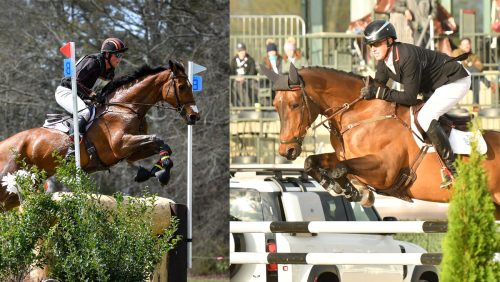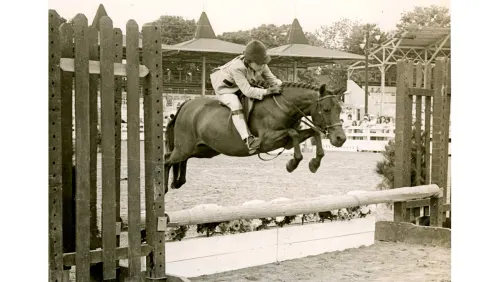Wellington, Fla.—Jan. 5
Winning equitation championships is what qualified a lot of the riders for the USEF George H. Morris Horsemastership Clinic, but Anne Kursinski reminded them during Thursday’s flat lessons that the buck doesn’t stop with a blue ribbon in the Maclay.
“Equitation is important, and not in terms of being frozen for a judge,” Kursinski said. “It’s not about being a mannequin up there—it’s about being supple and elastic and in the right place at the right time.”
Kursinski put the 12 riders through their paces, asking them to do lateral work, extensions, collections, corrections of their horse’s faults and their own—and of the utmost importance was what their position was doing to help the horse.
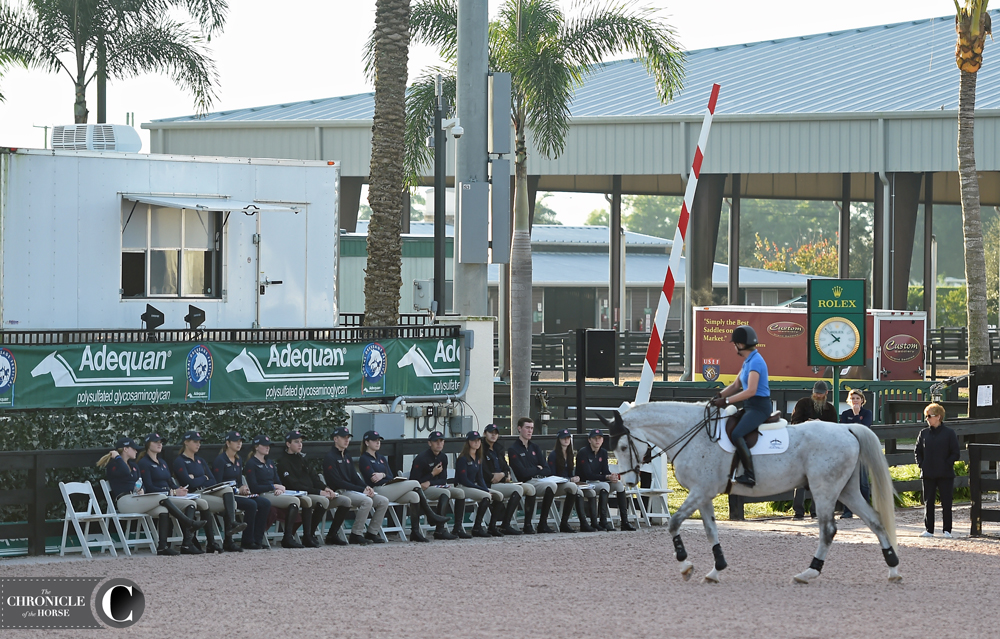
Anne Kursinski addresses the 12 clinic riders before demonstrating how she works a horse on the flat. Photo by Ann Glavan
Sit The Saddle
If there was one phrase Kursinski used more than all others, it was “sit the saddle.” Is your horse acting up? Sit the saddle. Horse getting dull? Sit the saddle. Trying to get more engagement out of your lateral work? You guessed it, sit the saddle.

Kursinski demonstrates the position she wants riders to sit in from the ground. Photo by Ann Glavan.
Kursinski demonstrated what she meant by that both from the ground and from the back of rider Cooper Dean’s horse—Dean was having trouble getting his spicy horse to stay moving forward in the trot through the lateral work without breaking into a nervous canter or slowing backwards into the walk, and when his horse felt like it was about to break into the canter and tossed its head, Dean’s instinct was to stand slightly in his stirrups.
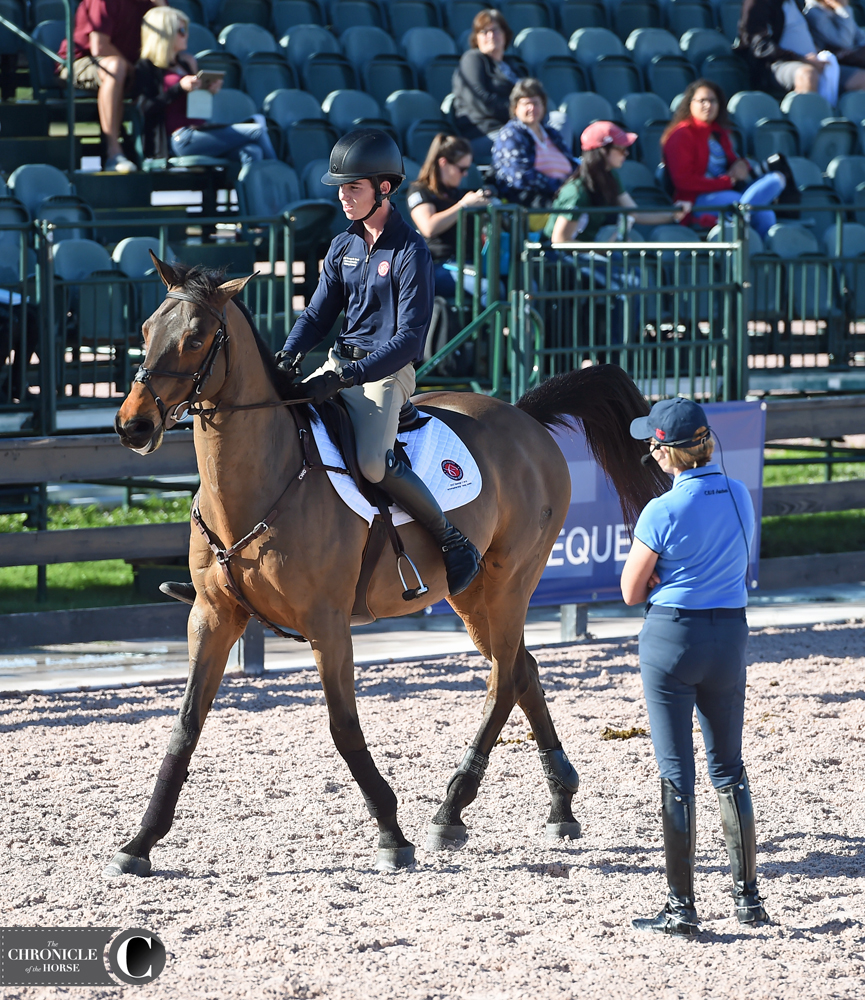
Cooper Dean sturggled to keep his hot horse on the bit through the lateral work. Photo by Ann Glavan.
Kursinski had Dean drop his stirrups, and almost immediately he had better luck keeping his horse at the desired gait. But Dean still struggled to get his horse to bring his head down and go on the bit—Kursinski had Dean dismount and she got on to show him how it’s done.

Kursinski shows Dean how she can give the rein, and the horse drops its head. Photo by Ann Glavan.
“He can do it, you just have to ask for it,” Kursinski told Dean, and indeed the difference in how the horse went for Kursinski was significant. It became much steadier in the contact and willing to drop its head and keep it there.
“When I give, they should go this way,” Kursinski demonstrated, bending at the waist. Indeed, when she gave Dean’s horse more rein, it dropped its head down instead of tossing it up.
For Kursinski, the difference was in her use of her entire body to manage the hot horse.
“McLain’s whole body rides the horse, Beezie’s whole body rides the horse, you don’t see them pulling the horse’s head to the side with just their hand,” Kursinski said. “I had a trainer who used to say my hands are in my seat, my hands are in my back.”
ADVERTISEMENT
For The Naughty Nellies…
Kursinski started the day with a demonstration of how she would flat her horses at home. She saddled up Caspar’s Lasino, an 8-year-old horse she imported from Germany and has done in small grand prixs, to use in the demonstration.
Kursinski warned riders and auditors beforehand that Caspar could be a bit of a handful sometimes (it’s why she had both a gag and snaffle rein on the bridle), and as if to prove the point, Caspar started off the session spooking at anything and everything moving outside the ring, with some rather athletic airs above ground to really voice his displeasure at the scenery around the stadium at the Global Dressage Festival show grounds.

One of Caspar’s more dramatic attempts at avoiding the monsters at the end of the ring. Photo by Ann Glavan.
“I don’t beat him up when he does that, I send him forward,” Kursinski said, waiting out Caspar’s rears and bucks and answering each with a quiet but firm encouragement forward.
“It’s communication with the horse, not dominating the horse. It’s not about over-powering,” Kursinski said. “It’s about getting them to express themselves.”
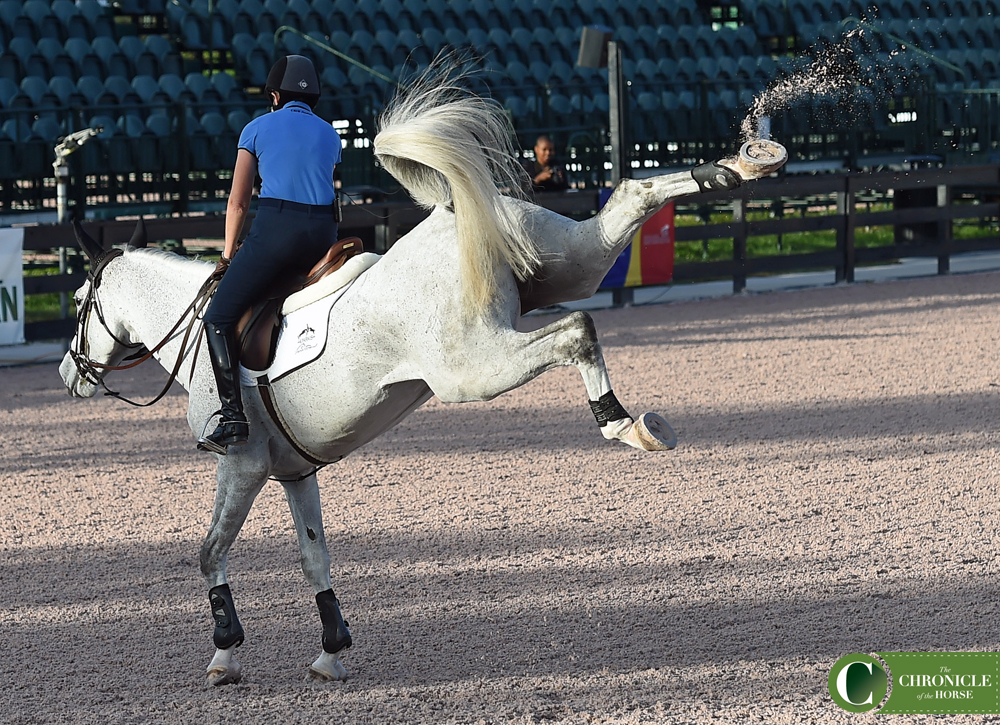
Anne Kursinski can certainly sit a good buck! Photo by Ann Glavan.
Caspar gradually got more and more comfortable in the ring, but every once in a while, a new arrival of auditors or a golf cart passing by made him act out. Kursinski continued to calmly encourage the horse forward, and would continue doing whatever exercise she had been attempting as soon as possible.
“I’m not beating him up when he gets nervous, I’m giving him confidence,” Kursinski explained. “When he’s bad I don’t attack, I sit.”
When Caspar decided he really had no interest in going near the side of the ring where some men were fixing part of a tent, Kursinski put him into a shoulder-in.

That’s more like it, Caspar! Photo by Ann Glavan.
“Right shoulder-in when he acts up, give him something else to think about,” Kursinski said. “The lateral work is mental, so he thinks more about me than the audience, and it’s also physical, it’s like us going to the gym.”
How’s that for a two-for-one exercise?
Not Going To Happen With A Knot
After warming the riders up briefly, Kursinski called all of them into the center of the ring and personally tied a knot in everyone’s reins.
“This will keep your hands out of your lap and together,” Kursinski said.
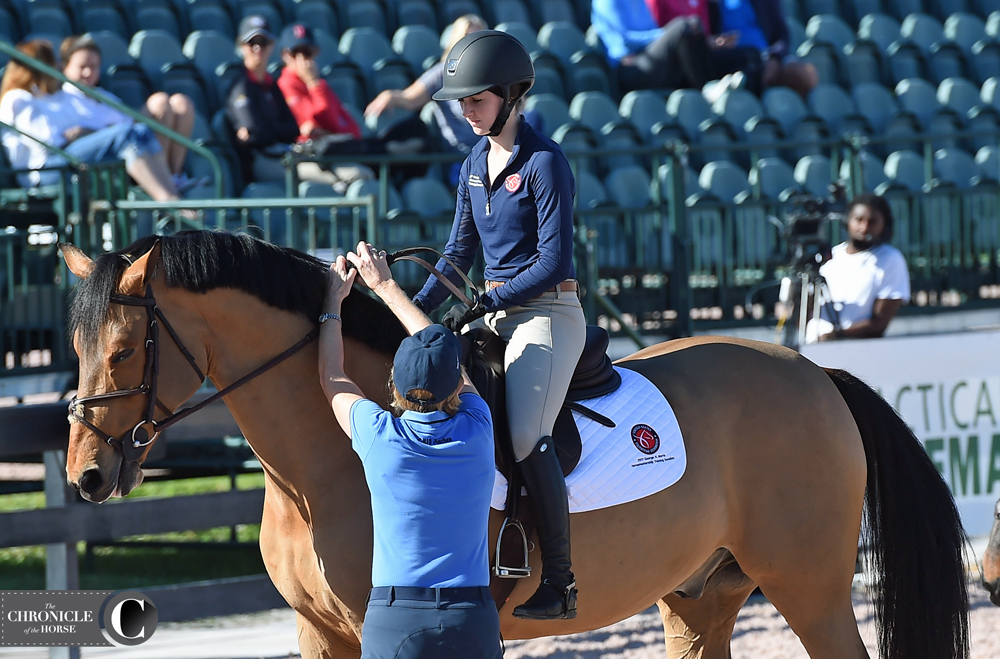
ADVERTISEMENT
Anne Kursinski tied each rider’s reins in a knot herself. Photo by Ann Glavan.
Most of the riders had their reins knotted for the duration of the sessions, including throughout the lateral, no-stirrups and transition work.
“You would think the knot would make them heavy,” Kursinski said. “But it actually makes them light from you taking and giving and getting them on the bit.”
At the end of the sessions Kursinski asked rider to tell her how they think the knot helped them.
“You have to use your body evenly, you have a harder time twisting,” said rider Gracie Marlowe.

Kursinski looks on as Coco Fath crosses the diagonal, working with her reins in a knot. Photo by Ann Glavan.
And Kursinski didn’t just talk the talk—when rider Maya Nayyar was struggling to get her horse to do a turn on the forehand with her reins knotted, Kursinski had her dismount and got on the horse herself to give a master class in the movement. With Nayyar, the horse wanted to back up and walk his front feet in a small circle with his back feet. Kursinski corrected each backward step using just her outside leg, and soon had the horse alternating down the rail in very correct turn on the haunches, turn on the forehand.
“This exercise helps you feel. Where are the front legs, where are the back legs?” Kursinski explained.
Adventure Out To Get Inside The Mind Of A Horse
While walking her horse out after her own riding demonstration, Kursinski fielded questions from some of the riders and talked about her own riding history that led to her successful career.
Part of that success came from not limiting herself to learning from only show jumping instructors.
“I rode cutting horses, I rode Saddlebreds, I rode Lipizzaners, I did dressage, I asked the eventers what they fed their horses and how they kept them fit,” Kursinski said, chuckling at her own many and varied resume. “It’s about getting inside the horse, what makes them tick, what makes them better, how to get the most out of them.
“That’s the fun of it, and honestly it will improve your jumping,” Kursinski continued. “It just makes you a better horseperson to get inside the horse, and it’s fun, fun, fun. I hope you get how much fun it is.”
Getting in the saddle yourself isn’t even a prerequisite for learning in Kursinski’s mind.
“Watch the great riders, when you get a chance, and ask questions,” Kursinski said. “I was always following Jimmy Williams around, maybe in places I shouldn’t have been, looking around corners at the barn, saying, ‘What can I learn?’ and being inquisitive.”
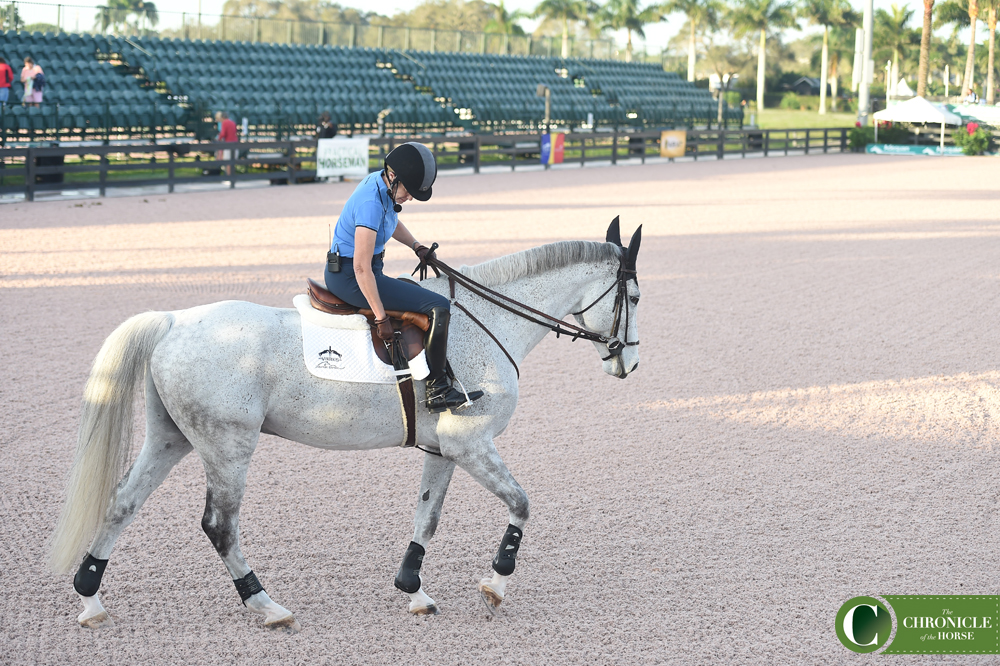
Anne Kursinski demonstrates the George Morris-approved way to tighten your girth while on a horse. Photo by Ann Glavan.
Check back with the Chronicle on Jan. 6 and 7 for more coverage from the USEF George H. Morris Horsemastership clinic, and don’t forget to check out the Jan. 23 issue of the magazine for more in-depth analysis from the clinic. A schedule of the clinic can be found here and you can find live streaming from USEF Network here.






